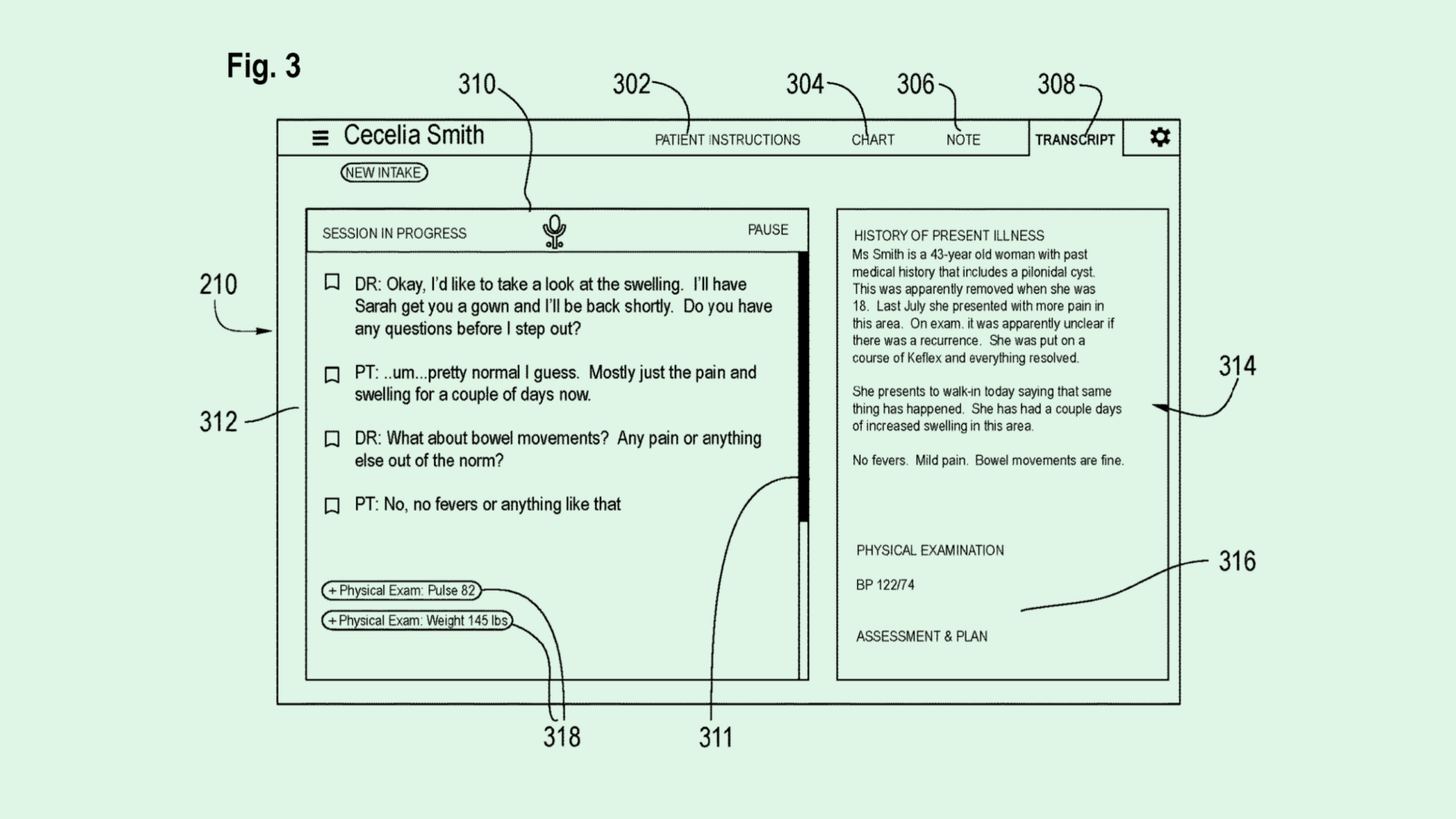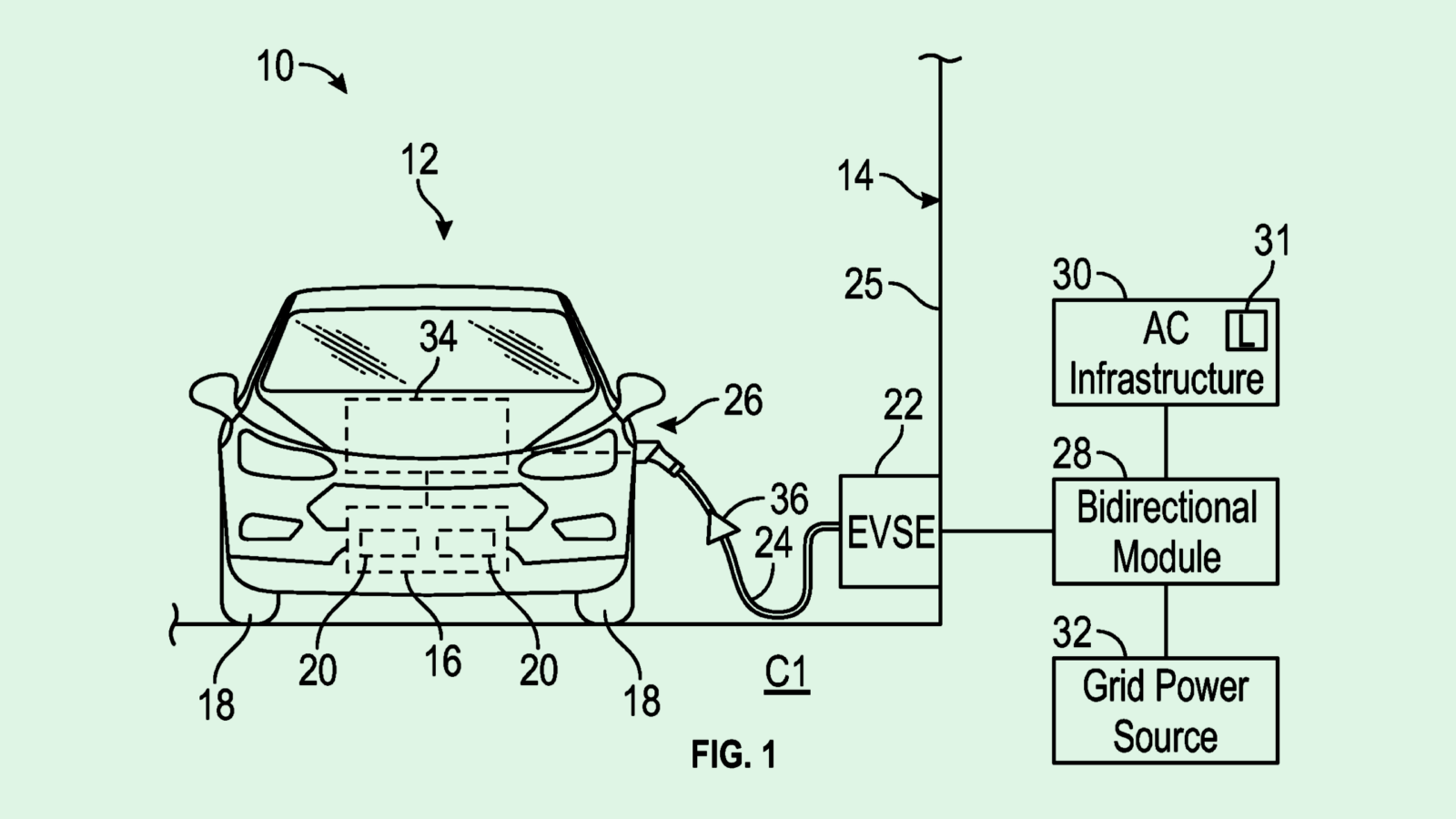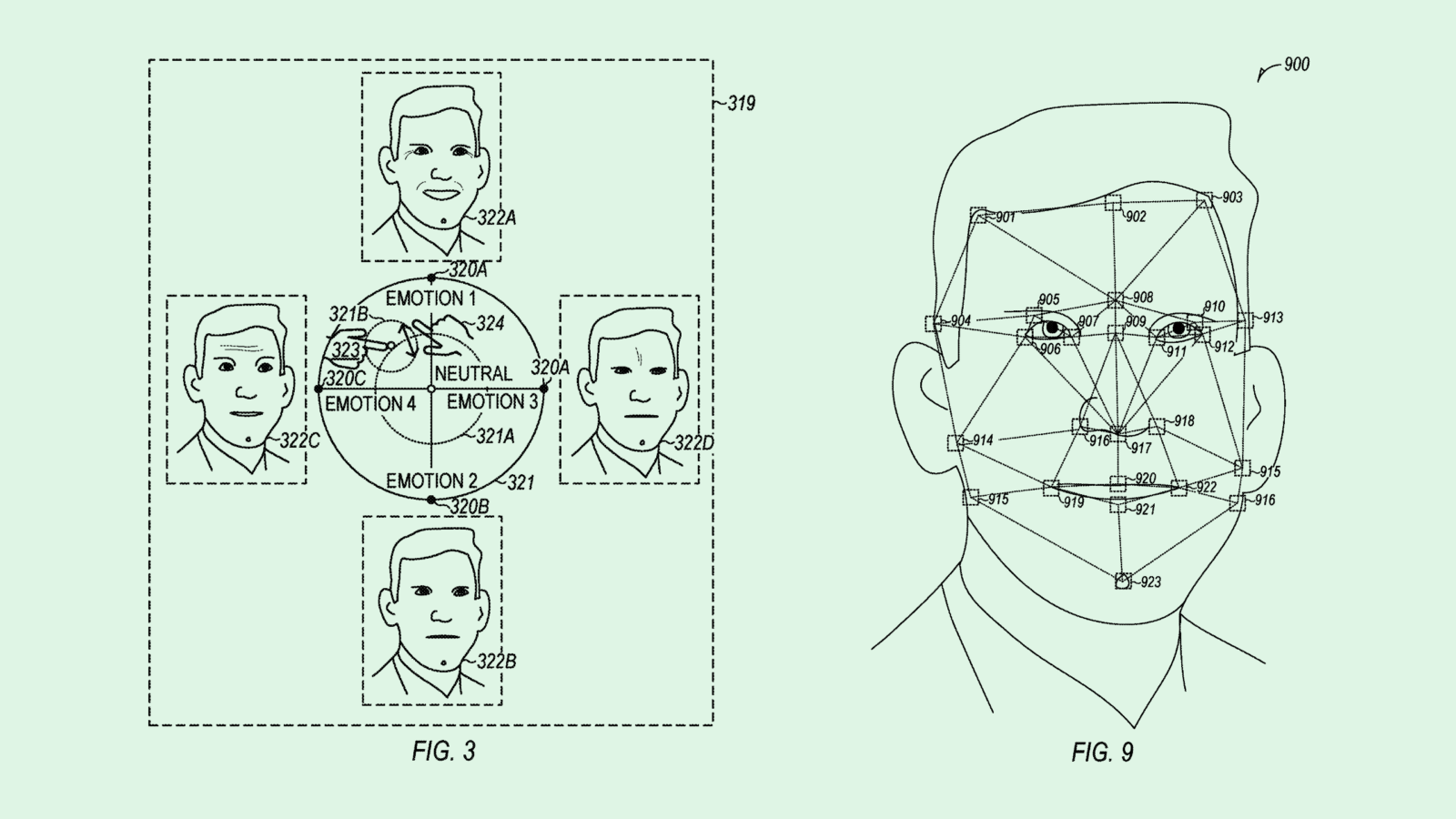Happy Monday and welcome to Patent Drop!
Today, Google’s patents for AI-based doctor’s assistants signal the growing use cases for AI in healthcare. Plus: Ford wants to charge vehicles on renewables, and Microsoft wants to know what makes you smile.
Let’s dive in.
Google Gets its M.D.
Google may want to bring its AI expertise to the doctor’s office. The company filed multiple patent applications related to machine learning-based note-taking and research assistance in healthcare settings.
First up, Google is seeking to patent a system for matching unstructured text to “clinical ontologies.” To put it simply, this uses a neural network to break down doctors’ notes and identify relationships between the terms used within them.
When it’s fed medical notes from an appointment, Google’s AI recognizes and extracts specific terms. For example, it may specifically pull out symptoms that the patient reported, along with their medical history, such as previous procedures or conditions. Then, it starts connecting the dots, such as finding relationships between symptoms, past conditions, and potential new diagnoses.
Google’s filing presents the potential for using a neural network as a diagnostic assistant, as AI is particularly talented at pattern recognition and data analysis.
The tech firm also may be looking at ways to spare doctors the grunt work. The company sought to patent an interface for “patient-provider conversation and auto-generation” of notes or summaries. As the title of this patent implies, this tech could provide rapid summary generation of patient office visits, either in real-time or post-appointment.
Using machine learning, this tool takes in an audio recording of a medical appointment, identifying speakers, transcribing their words, and summarizing the text by extracting specific medical terms or conditions discussed by the patient. This tool also links those extracted terms to specific medical sources. The summary is then displayed side-by-side with the transcript via an easy-to-use workstation interface for the doctor. This system also handles proper billing between patients and insurance companies through the notes, freeing up time that would typically be spent on administrative work.
Google noted that physicians spend on average 20% of their time creating notes, so the goal of this interface is “improving the efficiency of generating notes of patient visits that takes less time of physicians, allowing them to see more patients and spend more time on patient care.”

If these systems make it past the stereotypical doctor’s chicken-scratch handwriting, Google’s tech could help the severe understaffing in the US healthcare industry. According to the Association of American Medical Colleges, the US could face a shortage of up to 86,000 physicians by 2036. While these systems won’t be able to entirely replace a doctor, they could ease the load, freeing up more time to spend with patients.
Plus, AI works best when it has more data to work with. In healthcare settings, this tech would best be put to use on diagnosis and treatment of common diseases and conditions “where data is consistent and vast and patient outcomes are well understood,” said Luká Yancopoulous, CEO of healthcare supply chain software company Grapevine.
“That’s the largely curable and treatable diseases that fly under the radar, and people miss the opportunity to get the care they deserve,” Yancopoulous said.
But AI doesn’t come without its limitations. For one, these systems may not be useful when dealing with rare diseases or conditions with little data, said Yancopoulous, adding, “If the information isn’t available, how great can the predictive algorithm really be?”
The other issue is that healthcare professionals would need to have an understanding of the AI systems they’re using, said Amin Katouzian, co-founder and CEO of patient navigation app Rally Behind You. To perform well, these algorithms need close monitoring and a human co-pilot to prevent hallucinations that may lead to misdiagnosis.
“You not only need to be technologically competent, you also need to be healthcare-competent,” said Katouzian. “If the algorithm makes a mistake … there has to be a way that enables providers to modify them.”
Google has previously partnered with Epic, an electronic health records company, to integrate its systems into Google Cloud. Bringing its AI prowess into the mix could extend its current capabilities in a lucrative market.
“The use of AI in healthcare is inevitable,” said Katouzian. “And (Google) has everything that (healthcare) needs when it comes to AI infrastructure.”
Ford Goes Renewable
Despite the dip in the EV market, Ford wants to be prepared to charge.
The automaker filed a patent application for prioritizing vehicle charging from “renewable or low carbon emission sources.” This essentially aims to reduce both stress on the electrical grid and carbon emissions caused by excess charging demand.
Though EV owners may want to charge their cars in “ways that are as environmentally friendly as possible … electrified vehicle owners have traditionally not been able to accurately quantify and minimize carbon emissions when charging their vehicles,” Ford said in the filing.
Ford’s system would run charging based on what it calls an “eco charging schedule,” which would identify times when renewable and low-carbon energy sources are abundant enough that they exceed a specific threshold.
Ford’s cars may use “in-vehicle connectivity” — such as Bluetooth, WiFi, or in-vehicle data availability — to connect to a “grid data server” and get real-time information about the status of the energy available on the grid, and prioritize charging during those times. Along with electricity demand, it may also consider weather data, especially in the face of an extreme weather event like a storm or heat wave.
This tech may also track how much carbon dioxide the electrical grid is emitting in real-time, and consider that when planning when to charge, aiming for emissions to get below a certain threshold before allowing a vehicle to charge.
What’s more, Ford proposes a way for its vehicles to give back using bidirectional charging. For example, if a vehicle is plugged into a charger at a house that is using a lot of power (and thereby emitting more carbon), it can give power back “in a manner that minimizes the impact to the environment.” Or if the power goes out entirely, the vehicle can basically serve as a backup generator.

Ford has filed a multitude of applications for charging tech, including a way to balance scheduling and demand, a bidirectional power-sharing system, and a charging reservation interface.
But despite the company’s commitment to grabbing up electric vehicle IP, it’s started to temper its sales expectation as consumer demand has dropped pace. The company announced last week that it would delay production of new all-electric SUVs and pickup trucks, focusing instead on offering hybrids.
“The rationale seems to be that hybrids can offer many of the benefits of electric vehicles (e.g., improved fuel efficiency) without some of the current challenges around EV charging infrastructure,” Pedro Palandrani, VP and director of research at Global X ETFs. By investing in hybrids, Ford may be seeking to “gradually ease consumers” into fully electric vehicles down the road, he noted.
Increasing consumer interest in the long run may be a matter of lowering prices, Palandrani said. Ford seems to realize this, too, having cut the cost of its 2023 Mach-E below $40,000 for the first time in February.
Even though EV demand has taken a hit, investing in charging infrastructure sooner rather than later could be in Ford’s best interest, said Matt McCaffree, VP of Utility Market Development for EV charging service FLASH. Tech like this will allow the automaker to be prepared to meet demand when it eventually does rebound, he noted.
But Ford may also be preparing charging solutions before utility providers are ready for them, McCaffree noted. This patent in particular would require utilities to relay in-depth information about the state of available power on the grid, but those providers are “light years away from providing that kind of signal,” McCaffree said.
“We are multiple technological steps away from this happening,” said McCaffree. “I see a lot of innovation happening in the near-term going after things like peak load management, controlling demand of charging, or looking at peak hours of the day … which don’t require real-time signals like what’s being proposed in this patent.”
Microsoft Says Cheese
Microsoft wants to express how work meetings make you feel.
The tech firm filed a patent application for “intentional virtual user expressiveness.” This essentially aims to detect a user’s emotional state and have it reflected via renderings of facial animations.
“Facial emotions can be detected to enable richer meeting services for meeting and communication services,” Microsoft noted in the filing.
Microsoft’s tech offers a way to virtually display the emotional states of users by monitoring visual cues from movements in facial landmarks, such as smile lines, nose features, and eyebrows. This tech may also monitor and analyze audio data to determine whether or not a user’s sound or tone matches any particular emotion (this may be separate from the image data, or used as a means to supplement the emotional display).
Using a deep learning model, Microsoft takes in all of this data to determine how a user is feeling at any given moment, and the “magnitude” of their emotional state. Finally, a “facial animation model” creates an emotionally reflective rendering of the user, updating the animation in “real-time or near-real time.”
In addition, users are allowed to replace or assign different emotions to different facial expressions. For example, if a user frowns naturally with their resting face, they can designate that look as “neutral” rather than sad. Or if they don’t want to express negative emotions at all via their animations, they can choose to hide negative emotions.
It should be no surprise that Microsoft wants to get a feel for your feelings. The company has previously sought to patent systems to correct your tone in emails, an emotional support chatbot capable of psychological monitoring, and AI models that assess your well-being.

And Microsoft is just one of several tech companies that seem very intent on reading your emotions. Nvidia, Google, Amazon, Snap, and even Disney have patent applications that take a run at multiple kinds of emotion recognition for different purposes.
This type of personal data can be quite valuable to companies, whether it’s aimed at creating a better user experience by improving communications (as Microsoft’s tech seemingly intends), gauging reactions to different content or generally getting a read on user behaviors.
The only issue: Emotion-reading AI models have been widely criticized. For one thing, AI simply isn’t good at reading human emotions and is often limited to basic expressions that fall short of what a person is feeling. And because everyone shows emotion differently, AI models can’t reliably comprehend and offer insight into every kind of person. Plus, privacy is always an issue depending on the way emotion detection is implemented.
Microsoft has landed in hot water for this kind of tech in the past, retiring an emotion-detecting AI product in July of 2022 after it was criticized as being unscientific for equating external displays with internal feelings.
However, given that the original filing date of this patent was around three months after Microsoft retired this product and that it would allow users to override preset emotions, the company may still be working on ways to get emotion detection right.
Extra Drops
- Apple wants to fix the flash. The company is seeking to patent a method for “correcting images in flash photography.”
- Ford wants to understand its surroundings. The automaker filed a patent application for methods for “scene understanding”
- IBM wants to play HR. The company is seeking to patent “personalized risk and reward criteria for workforce management,” which helps plan vacation and time-off requests to reduce short staffing.
What Else is New?
- The U.S. has proposed to offer TSMC’s Arizona-based subsidiary up to $6.6 billion in funding via the CHIPS act to build factories.
- JPMorgan Chase now has more than 400 use cases for AI in production, CEO Jamie Dimon said in the bank’s letter to shareholders. Dimon noted that AI has the potential to “augment virtually every job.”
- Ripple CEO Brad Garlinghouse said he expects the entire crypto market’s value to double in size by the end of the year, reaching $5 trillion.
Patent Drop is written by Nat Rubio-Licht. You can find them on Twitter @natrubio__.
Patent Drop is a publication of The Daily Upside. For any questions or comments, feel free to contact us at patentdrop@thedailyupside.com.
